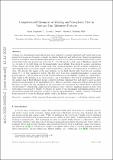Computational rheometry of yielding and viscoplastic flow in vane-and-cup rheometer fixtures
Author(s)
Chaparian, Emad; Owens, Crystal E.; McKinley, Gareth H.
Download2202.04255v2.pdf (10.69Mb)
Open Access Policy
Open Access Policy
Creative Commons Attribution-Noncommercial-Share Alike
Terms of use
Metadata
Show full item recordAbstract
A planar two-dimensional computational analysis is presented to qualify traditional and fractal vane-in-cup geometries for accurate rheometry of simple viscoplastic fluids with and without slip. Numerical simulations based on an adaptive augmented Lagrangian scheme are used to study the two-dimensional flow field of yield-stress fluids within and around vane tools with N=3 to 24 arms for a wide range of Bingham numbers, B (i.e. the ratio of the yield stress over the characteristic viscous stress). This allows for accurate calculations of the velocity and stress fields around vanes with various geometries, as well as direct comparison to experimental observations of the output torque measured by a rheometer, revealing sources of variation and error. We describe the impact of the vane structure on the fluid velocity field, from few-arm cruciform vanes (N < 6) that significantly perturb the flow away from ideal azimuthal kinematics, to many-arm fractal vanes (N > 12) in which the internal structural features are successfully ``cloaked" by a yield surface. This results in the shearing of an almost-circular ring of viscoplastic fluid that is indistinguishable from the annular ring of fluid deformed around a slip-free rotating cylindrical bob and leads to more accurate rheometric measurements of the material flow curve. Moreover, in direct comparison with data from previous literature, we show that slip conditions on the vane surface do not impact the velocity field or measured overall torque T, whereas slip conditions on the smooth outer wall have significant impact on data, even when using a vane geometry. Finally, we describe the impact of vane topography and Bingham number, B, on the measured torque and rheometric accuracy of vane-in-cup geometries for ``simple" (inelastic) yield-stress fluids described by either the Bingham plastic or Herschel-Bulkley constitutive model.
Date issued
2022-09Department
Hatsopoulos Microfluids Laboratory (Massachusetts Institute of Technology); Massachusetts Institute of Technology. Department of Mechanical EngineeringJournal
Journal of Non-Newtonian Fluid Mechanics
Publisher
Elsevier BV
Citation
Chaparian, Emad, Owens, Crystal E. and McKinley, Gareth H. 2022. "Computational rheometry of yielding and viscoplastic flow in vane-and-cup rheometer fixtures." Journal of Non-Newtonian Fluid Mechanics, 307.
Version: Author's final manuscript
ISSN
0377-0257
Keywords
Applied Mathematics, Mechanical Engineering, Condensed Matter Physics, General Materials Science, General Chemical Engineering